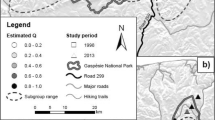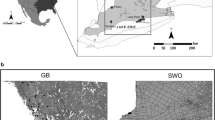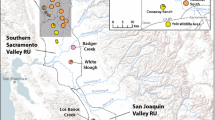Abstract
An understanding of genetic diversity and population structure is important to the conservation of declining species within fragmented habitats. These issues become critical for small, isolated populations, in which stochasticity is a main driver of genetic change and possibly of population extinction. In eastern New York and New England the endemic New England cottontail has declined due to habitat loss and fragmentation. As a species that exhibits metapopulation dynamics, habitat fragmentation can have profound implications for its persistence. We examined genetic diversity, population structure, and effective population size (Ne) of New England cottontails in New York, a purported remnant stronghold for the species. We amplified ten microsatellite loci from tissues collected from live-captures and from fecal pellets. We investigated potential hierarchical population structuring using programs STRUCTURE and BAPS. STRUCTURE identified four hierarchical tiers consisting of nine clusters, and BAPS clustering was highly consistent with that given by STRUCTURE. Most populations displayed significant genetic differentiation (FST = 0.04–0.34) and little to no evidence of ongoing connectivity. Low genetic diversity was observed based on allelic richness (2.2–3.0), and all populations had critically low effective population sizes (Ne; 2.7–57.1). Observed trends in population subdivision, genetic diversity, and Ne were consistent with reported trends in the state-endangered Maine-New Hampshire populations, and not indicative of a genetic stronghold within New York. Instead, the small and isolated populations observed here imply a breakdown in metapopulation functionality indicative of conditions faced by the species range-wide and an immediate need for human intervention to restore connectivity and rebuild populations.






Similar content being viewed by others
References
Amaral KE, Palace M, O’Brien KM, Fenderson LE, Kovach AI (2016) Anthropogenic habitats facilitate dispersal of an early successional obligate: implications for restoration of an endangered ecosystem. PLoS ONE 11:e0148842
Balkenhol N, Waits LP (2009) Molecular road ecology: exploring the potential of genetics for investigating transportation impacts on wildlife. Mol Ecol 18:4151–4164
Batson WG, Gordon IJ, Fletcher DB, Manning AD (2015) Translocation tactics: a framework to support the IUCN Guidelines for wildlife translocations and improve the quality of applied methods. J Appl Ecol 52:1598–1607
Bauer ML (2018) Assessing the effects of habitat restoration on shrubland specialists: case study on the New England cottontail and shrubland birds. Thesis, University of New Hampshire, Durham, NH
Benjamini Y, Hochberg Y (2000) On the adaptive control of the false discovery rate in multiple testing with independent statistics. J Educ Behav Stat 25:60–83
Brichieri-Colombi TA, Moehrenschlager A (2016) Alignment of threat, effort, and perceived success in North American conservation translocations. Conserv Biol 30:1159–1172
Broquet T, Petit E (2004) Quantifying genotyping errors in noninvasive population genetics. Mol Ecol 13:3601–3608
Brubaker DR, Kovach AI, Ducey MJ, Jakubas WJ, O’Brien KM (2014) Factors influencing detection in occupancy surveys of a threatened lagomorph. Wildl Soc Bull 38:513–523. https://doi.org/10.1002/wsb.416
Cheeseman AE (2017) Factors limiting recovery of the New England cottontail in New York. Dissertation, State University of New York College of Environmental Science and Forestry, Syracuse, NY
Cheeseman AE, Ryan SJ, Whipps CM, Cohen JB (2018) Competition alters seasonal resource selection and promotes use of invasive shrubs by an imperiled native cottontail. Ecol Evol 8:11122–11133
Cheeseman AE, Cohen JB, Ryan SJ, Whipps CM (2019) Determinants of home range size of imperiled New England and introduced eastern cottontails. Can J Zool 97:516–523
Chessel D, Dufour AB, Thioulouse J (2004) The ade4 package-I-one-table methods. R News 4:5–10
Corander J, Sirén J, Arjas E (2008) Bayesian spatial modeling of genetic population structure. Comput Stat 23:111–129
DeMay SM, Becker PA, Rachlow JL, Waits LP (2017) Genetic monitoring of an endangered species recovery: demographic and genetic trends for reintroduced pygmy rabbits (Brachylagus idahoensis). J Mammal 98:350–364
Do C, Waples RS, Peel D, Macbeth G, Tillett BJ, Ovenden JR (2014) NeEstimator v2: re-implementation of software for the estimation of contemporary effective population size (Ne) from genetic data. Mol Ecol Resour 14:209–214
Earl DA (2012) STRUCTURE HARVESTER: a website and program for visualizing STRUCTURE output and implementing the Evanno method. Conserv Genet Resour 4:359–361
Estes-Zumpf WA, Rachlow JL, Waits LP, Warheit KI (2010) Dispersal, gene flow, and population genetic structure in the pygmy rabbit (Brachylagus idahoensis). J Mammal 91:208–219. https://doi.org/10.1644/09-Mamm-a-032r.1
Evanno G, Regnaut S, Goudet J (2005) Detecting the number of clusters of individuals using the software STRUCTURE: a simulation study. Mol Ecol 14:2611–2620
Fenderson LE (2010) Landscape genetics of the New England cottontail: effects of habitat fragmentation on population genetic structure and dispersal. Thesis, University of New Hampshire, Durham, NH
Fenderson LE, Kovach AI, Litvaitis JA, Litvaitis MK (2011) Population genetic structure and history of fragmented remnant populations of the New England cottontail (Sylvilagus transitionalis). Conserv Genet 12:943–958
Fenderson LE, Kovach AI, Litvaitis JA, O’Brien KM, Boland KM, Jakubas WJ (2014) A multiscale analysis of gene flow for the New England cottontail, an imperiled habitat specialist in a fragmented landscape. Ecol Evol 4:1853–1875. https://doi.org/10.1002/ece3.1068
Forys E, Humphrey SR (1999) The importance of patch attributes and context to the management and recovery of an endangered lagomorph. Landsc Ecol 14:177–185. https://doi.org/10.1023/a:1008013831843
François O, Durand E (2010) Spatially explicit Bayesian clustering models in population genetics. Mol Ecol Resour 10:773–784
Frankham R, Ballou JD, Eldridge MD, Lacy RC, Ralls K, Dudash MR, Fenster CB (2011) Predicting the probability of outbreeding depression. Conserv Biol 25:465–475
Frankham R, Bradshaw CJA, Brook BW (2014) Genetics in conservation management: revised recommendations for the 50/500 rules, Red List criteria and population viability analyses. Biol Conserv 170:56–63. https://doi.org/10.1016/j.biocon.2013.12.036
Frankham R (2015) Genetic rescue of small inbred populations: meta-analysis reveals large and consistent benefits of gene flow. Mol Ecol 24:2610–2618
Frantz A, Pope L, Carpenter P, Roper T, Wilson G, Delahay R, Burke T (2003) Reliable microsatellite genotyping of the Eurasian badger (Meles meles) using faecal DNA. Mol Ecol 12:1649–1661
Fuller S, Tur A (2012) Conservation strategy for the New England cottontail (Sylvilagus transitionalis). https://newenglandcottontail.org/sites/default/files/conservation_strategy_final_12-3-12.pdf. Accessed 10 July 2018
Galpern P, Manseau M, Hettinga P, Smith K, Wilson P (2012) Allelematch: an R package for identifying unique multilocus genotypes where genotyping error and missing data may be present. Mol Ecol Resour 12:771–778
Gilbert KJ, Whitlock MC (2015) Evaluating methods for estimating local effective population size with and without migration. Evolution 69:2154–2166
Griffith B, Scott JM, Carpenter JW, Reed C (1989) Translocation as a species conservation tool: status and strategy. Science 245:477–480
Guinand B, Scribner KT, Page KS, Filcek K, Main L, Burnham-Curtis MK (2006) Effects of coancestry on accuracy of individual assignments to population of origin: examples using Great Lakes lake trout (Salvelinus namaycush). Genetica 127:329–340
Haddad NM et al (2015) Habitat fragmentation and its lasting impact on Earth’s ecosystems. Sci Adv 1:e1500052
Hanski I (2011) Habitat loss, the dynamics of biodiversity, and a perspective on conservation. Ambio 40:248–255
Hoffmann AA, Sgrò CM (2011) Climate change and evolutionary adaptation. Nature 470:479
Hubisz MJ, Falush D, Stephens M, Pritchard JK (2009) Inferring weak population structure with the assistance of sample group information. Mol Ecol Resour 9:1322–1332
Jakobsson M, Rosenberg NA (2007) CLUMPP: a cluster matching and permutation program for dealing with label switching and multimodality in analysis of population structure. Bioinformatics 23:1801–1806
Jamieson IG, Allendorf FW (2012) How does the 50/500 rule apply to MVPs? Trends Ecol Evol 27:578–584
Jombart T (2008) adegenet: a R package for the multivariate analysis of genetic markers. Bioinformatics 24:1403–1405. https://doi.org/10.1093/bioinformatics/btn129
Kalinowski ST, Taper ML, Marshall TC (2007) Revising how the computer program CERVUS accommodates genotyping error increases success in paternity assignment. Mol Ecol 16:1099–1106
Kamvar ZN, Tabima JF, Grünwald NJ (2014) Poppr: an R package for genetic analysis of populations with clonal, partially clonal, and/or sexual reproduction. PeerJ 2:e281
Keenan K, McGinnity P, Cross TF, Crozier WW, Prodöhl PA (2013) diveRsity: an R package for the estimation and exploration of population genetics parameters and their associated errors. Methods Ecol Evol 4:782–788
Keller LF, Waller DM (2002) Inbreeding effects in wild populations. Trends Ecol Evol 17:230–241
King JL, Duncan CL, Garcelon DK (2014) Status of the Santa Catalina Island fox thirteen years after its decline. Monogr West N Am Nat 7:382–396
King TL, Eackles M, Aunins A, McGreevy TJ, Husband TP, Tur A, Kovach AI (2017) Microsatellite marker development from next-generation sequencing in the New England cottontail (Sylvilagus transitionalis) and cross-amplification in the eastern cottontail (S. floridanus). BMC Res Notes 10:741
Kovach AI, Litvaitis MK, Litvaitis JA (2003) Evaluation of fecal mtDNA analysis as a method to determine the geographic distribution of a rare lagomorph. Wildl Soc Bull 31:1061–1065
Kristensen TV, Kovach AI (2018) Spatially explicit abundance estimation of a rare habitat specialist: implications for SECR study design. Ecosphere 9:e02217
Litvaitis MK, Litvaitis JA (1996) Using mitochondrial DNA to inventory the distribution of remnant populations of New England cottontails. Wildl Soc Bull 24:725–730
Litvaitis JA, Villafuerte R (1996) Factors affecting the persistence of New England cottontail metapopulations: the role of habitat management. Wildl Soc Bull 24:686–693
Litvaitis MK, Litvaitis JA, Lee WJ, Kocher TD (1997) Variation in the mitochondrial DNA of the Sylvilagus complex occupying the northeastern United States. Can J Zool 75:595–605. https://doi.org/10.1139/Z97-074
Moro D (2003) Translocation of captive-bred dibblers Parantechinus apicalis (Marsupialia: Dasyuridae) to Escape Island, Western Australia. Biol Conserv 111:305–315. https://doi.org/10.1016/S0006-3207(02)00296-3
Newmark WD (1995) Extinction of mammal populations in western North American national parks. Conserv Biol 9:512–526
Nomura T (2008) Estimation of effective number of breeders from molecular coancestry of single cohort sample. Evol Appl 1:462–474
Paetkau D, Slade R, Burden M, Estoup A (2004) Genetic assignment methods for the direct, real-time estimation of migration rate: a simulation-based exploration of accuracy and power. Mol Ecol 13:55–65
Papanastassiou K (2015) A landscape genetics approach for comparing connectivity across the range of the New England cottontail. Thesis, University of New Hampshire, Durham, NH
Piry S, Alapetite A, Cornuet J-M, Paetkau D, Baudouin L, Estoup A (2004) GENECLASS2: a software for genetic assignment and first-generation migrant detection. J Hered 95:536–539
Pompanon F, Bonin A, Bellemain E, Taberlet P (2005) Genotyping errors: causes, consequences and solutions. Nat Rev Genet 6:847–859
Pritchard JK, Stephens M, Donnelly P (2000) Inference of population structure using multilocus genotype data. Genetics 155:945–959
Puechmaille SJ (2016) The program structure does not reliably recover the correct population structure when sampling is uneven: subsampling and new estimators alleviate the problem. Mol Ecol Resour 16:608–627
Rannala B, Mountain JL (1997) Detecting immigration by using multilocus genotypes. Proc Natl Acad Sci USA 94:9197–9201
Raymond M, Rousset F (1995) GENEPOP (version 1.2): population genetics software for exact tests and ecumenicism. J Hered 86:248–249
Reed DH, Frankham R (2003) Correlation between fitness and genetic diversity. Conserv Biol 17:230–237
Robson KM, Lamb CT, Russello MA (2016) Low genetic diversity, restricted dispersal, and elevation-specific patterns of population decline in American pikas in an atypical environment. J Mammal 97:464–472
Rosenberg NA (2004) DISTRUCT: a program for the graphical display of population structure. Mol Ecol Resour 4:137–138
Ryan SJ, Gavard EJ, Cheeseman AE, Cohen JB, Whipps CM (2016) Reference and baseline hematocrit measures for the threatened New England cottontail (Sylvilagus transitionalis) and comparison with sympatic eastern cottontail (Sylvilagus floridanus) rabbits. J Zoo Wildl Med 47:659–662
Singer FJ, Papouchis CM, Symonds KK (2000) Translocations as a tool for restoring populations of bighorn sheep. Restor Ecol 8:6–13. https://doi.org/10.1046/j.1526-100x.2000.80061.x
Slatkin M (1987) Gene flow and the geographic structure of natural populations. Science 236:787–792
Szpiech ZA, Jakobsson M, Rosenberg NA (2008) ADZE: a rarefaction approach for counting alleles private to combinations of populations. Bioinformatics 24:2498–2504. https://doi.org/10.1093/bioinformatics/btn478
U.S. Fish and Wildlife Service [USFWS] (2006) Endangered and Threatened wildlife and plants; review of native species that are candidates or proposed for listing as Endangered or Threatened; annual notice of findings on resubmitted petitions; annual description of progress on listing actions. Fed Reg 71:53755–53835
U.S. Fish and Wildlife Service [USFWS] (2015) Endangered and Threatened wildlife and plants; 12-month finding on a petition to list the new england cottontail as an Endangered or Threatened Species. Fed Reg 80:55286–55304
Van Oosterhout C, Hutchinson WF, Wills DP, Shipley P (2004) MICRO-CHECKER: software for identifying and correcting genotyping errors in microsatellite data. Mol Ecol Notes 4:535–538
Verhoeven KJ, Simonsen KL, McIntyre LM (2005) Implementing false discovery rate control: increasing your power. Oikos 108:643–647
Waits LP, Luikart G, Taberlet P (2001) Estimating the probability of identity among genotypes in natural populations: cautions and guidelines. Mol Ecol 10:249–256
Waples RS, Do C (2008) LDNE: a program for estimating effective population size from data on linkage disequilibrium. Mol Ecol Resour 8:753–756
Warren AR (2017) An evaluation of New England cottontail habitat restoration. Thesis, University of New Hampshire, Durham, NH
Weckworth BV, Musiani M, DeCesare NJ, McDevitt AD, Hebblewhite M, Mariani S (2013) Preferred habitat and effective population size drive landscape genetic patterns in an endangered species. Proc R Soc B 280:1–9. https://doi.org/10.1098/rspb.2013.1756
Whipps C, Gavard EJ, Cohen JB, Ryan SJ (2019) Gastrointestinal parasites of the New England cottontail (Sylvilagus transitionalis) and eastern cottontail (Sylvilagus floridanus) in the Hudson Valley, New York. Parasitol Res, in press
Whiteley AR, Coombs JA, Hudy M, Robinson Z, Colton AR, Nislow KH, Letcher BH (2013) Fragmentation and patch size shape genetic structure of brook trout populations. Can J Fish Aquat Sci 70:678–688. https://doi.org/10.1139/cjfas-2012-0493
Whitlock MC (2000) Fixation of new alleles and the extinction of small populations: drift load, beneficial alleles, and sexual selection. Evolution 54:1855–1861
Acknowledgements
The New York State Department of Environmental Conservation (NYSDEC) (Grant No. 66287) and G Douglas provided funding, field support and property access. The USDA McIntire-Stennis Program of SUNY-ESF and the Edna Bailey Sussman Foundation provided additional funding. D Rosenblatt, P Novak, J Jaycox, L Masi, and E Burns provided field assistance and technical support. T Goodie and H Kilpatrick provided training. The United States Fish and Wildlife Service and Maine Department of Inland Fisheries and Wildlife provided additional radio collars. The New York State Department of Parks, Recreation, and Historic Preservation, National Park Service, and Clean Air Fund provided additional land access. KE Alger, KAW Lindsay, S Benedict, and C Michaud provided laboratory support. S Silver, M Hall, J Bittner, C Conte, J DeCotis, S Dermody, K Deweese, J Droke, I Dudley, D Eline, E Gavard, T Hillman, R Kelble, E Kohler, E McKean, S Mello, M Ratchford, E Reuber, S Sultaire, J Wojcik and the NYSDEC and Queen’s Zoo assisted with fieldwork.
Author information
Authors and Affiliations
Corresponding author
Additional information
Publisher's Note
Springer Nature remains neutral with regard to jurisdictional claims in published maps and institutional affiliations.
Electronic supplementary material
Below is the link to the electronic supplementary material.
Rights and permissions
About this article
Cite this article
Cheeseman, A.E., Cohen, J.B., Whipps, C.M. et al. Hierarchical population structure of a rare lagomorph indicates recent fragmentation has disrupted metapopulation function. Conserv Genet 20, 1237–1249 (2019). https://doi.org/10.1007/s10592-019-01206-z
Received:
Accepted:
Published:
Issue Date:
DOI: https://doi.org/10.1007/s10592-019-01206-z




